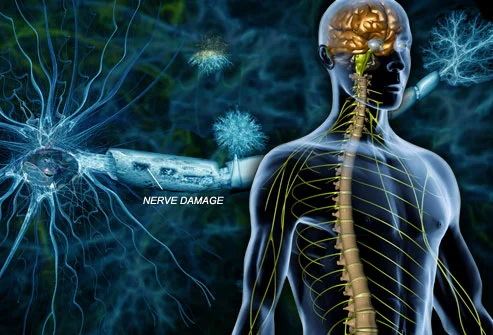Neurological Effects of Demyelination: Lhermitte’s Sign and Charcot-Marie-Tooth Disease
/By Abigail Yap
Lhermitte’s Sign, also known as the “barber chair” phenomenon, refers to an electric sensation that travels down the spine from the neck to the limbs. First described in 1917 by patients with multiple sclerosis (MS), Lhermitte’s Sign did not gain formal recognition until French neurologist Jean Lhermitte published a detailed report on the phenomenon a few years later (Lim et al., 2010).
Studies have shown that Lhermitte’s Sign is experienced by approximately one third of patients suffering from MS, a demyelinating disease. Demyelination refers to the degeneration and loss of the myelin sheath, a covering that insulates nerve axons and is important for proper neuronal transmission and interaction. In the case of Lhermitte’s Sign, demyelination of the cervical spine causes it to become hyper excitable. As a result of this increase in neural firing, the stretching of the cervical region that occurs upon flexion of the neck is sufficient to induce a radiating electric sensation throughout the body—the “barber chair” phenomenon (Khare and Seth, 2015). Because a healthy myelin sheath depends upon vitamin B-12, Lhermitte’s Sign can also result from B-12 deficiency. In addition to the forward bending of the neck, stress, fatigue, and overheating may also trigger the electric sensation.
Though it is most often observed in MS patients, Lhermitte’s Sign can also be associated with other conditions that may affect the upper neck region, such as Behcet’s disease, myelopathy, disc herniation, spondylosis, spinal cord injury or tumors, and Arnold-Chiari malformation. Furthermore, numerous reports have also established some connection between Lhermitte’s Sign and radiation chemotherapy (O’Reilly et al., 2014). A case study by Lim et al. of a 55-year-old patient undergoing chemotherapy for head and neck cancer showed the development of a transient “electric sensation” shortly after the start of treatment; it is hypothesized that radiation interferes with the production of oligodendrocytes, cells that make up the structure of the myelin sheath (Lim et al., 2010). Separate studies by Ko et al. suggest that there may be a threshold dose of radiation needed for this progression of Lhermitte’s Sign to occur (Ko et al., 2015).
Lhermitte’s Sign may cause a patient discomfort, but the phenomenon itself is not dangerous or life threatening. Symptoms can be controlled by adjusting posture, stretching, and wearing a brace to prevent any rapid neck movements. Medications such as steroids, anticonvulsants, and antidepressants can help to reduce pain. If more serious or invasive forms of treatment are required, low-voltage stimulation of the spinal cord may be able to alleviate some discomfort.
Charcot-Marie-Tooth (CMT) disorder, another neurological symptom seen in everyday practice, is an inherited condition characterized by the deterioration of motor and sensory nerves in the limbs (Szigeti et al., 2009). First discovered by physicians Jean-Martin Charcot, Pierre Marie, and Howard Henry Tooth in 1886, CMT is one of the most prevalent genetic neurological disorders. Patients suffering from CMT disease often experience weakness in the feet and lower legs, which can cause physical deformities and/or interfere with their ability to walk. As the condition progresses, this peripheral neuropathy can spread to affect motor function of the hands and tongue. These symptoms are highly variable and develop gradually, and onset typically occurs sometime between adolescence and mid-adulthood. Although some patients with severe cases of CMT may have impaired mobility and/or difficulty breathing, the condition is non-fatal and does not affect life expectancy.
Similar to Lhermitte’s Sign, the symptoms of CMT disease are most often caused by axon demyelination. In the case of CMT1, inherited gene mutations prevent the proper formation of proteins needed to form the myelin sheath surrounding peripheral motor and sensory nerves. As a result of this reduced transmission of motor and sensory information, muscle movements weaken and the ability to sense pain and temperature can be impaired. In a less common form of the condition, CMT2, mutations affect the functionality of the peripheral nerve itself rather than the sheath surrounding it.
CMT disease can be diagnosed through a standard neurological examination. Signs of CMT include a decrease in muscle bulk and strength, impaired reflexes, sensory loss, foot deformities, and nerve enlargement. Electromyograms, genetic tests, and biopsies can be performed to detect for axonal abnormalities and provide more definitive results for diagnosis. There is no cure for CMT disease, but physical therapy, low-impact endurance exercises, and orthopedic devices can help to maintain muscle strength and minimize atrophy. Upon further research, future treatments may aim to repair mutated genes or reverse the processes of demyelination and nerve degeneration.
References
Khare S, Seth D. Lhermitte's Sign: The Current Status. Ann Indian Acad Neurol. 2015;18(2):154–156. doi:10.4103/0972-2327.150622
Ko HC, Powers AR, Sheu RD, et al. Lhermitte's Sign following VMAT-Based Head and Neck Radiation-Insights into Mechanism. PLoS One. 2015;10(10):e0139448. Published 2015 Oct 8. doi:10.1371/journal.pone.0139448
Lim DC, Gagnon PJ, Meranvil S, Kaurin D, Lipp L, Holland JM. Lhermitte's Sign Developing after IMRT for Head and Neck Cancer. Int J Otolaryngol. 2010;2010:907960. doi:10.1155/2010/907960
O'Reilly A, Ryan S, MacEneaney P, O'Reilly S, P, Cronin S, Power D, G: Lhermitte's Phenomenon and Platinum, Beware of Latency. Oncol Res Treat. 2014;37:591-594. doi: 10.1159/000365539
Szigeti K, Lupski JR. Charcot-Marie-Tooth disease. Eur J Hum Genet. 2009;17(6):703-710. doi:10.1038/ejhg.2009.31



